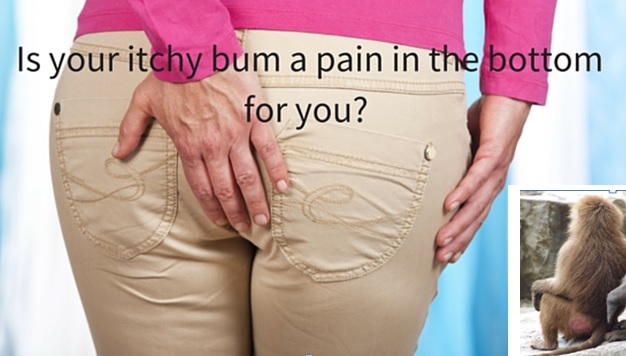
What is Pruritus ani? Pruritus ani is an unpleasant sensation that provokes an intolerable desire to scratch the skin around the anal area. It has been recognised since antiquity and seems to affect 1% to 5% of the population. It is a latin term meaning itchy anus. It is called “idiopathic pruritus ani” when no clear cause is found. Men are affect 4 times more than woman, most commonly first experienced between 40-65 years. Contributing factors are found in up to 75% of cases including anorectal skin conditions and infections.
What causes pruritus ani? The perianal skin is oily, mildly acidic and naturally protecting and seems more prone to itch than other body areas. Irritants may be mechanical, thermal, chemical, or electrical. If these irritate pain related C-fibre nerve endings (pain receptors – nociceptors) they cause pain, and if they irritate itch-related nerve endings (itch sensors – pruriceptors), they cause itch. Itch sensors in the upper layer of skin around the anus are often activated more at night and after a bowel movement and by heat, wool, moisture, faecal leaking or soiling, stress, and anxiety. Subsequent scratching causes skin damage and “activation” of itch sensors - which may then increase in number or sensitivity. Skin damage is first microscopic, then it may become inflamed and later it may thicken and ulcerate. Some patients have transient or longer anal sphincter relaxation (worsened by things like prior anal or pelvic surgery and even coffee) which can lead to silent faecal soiling with leakage of further irritants such as enzymes and bacteria. These trigger the “activated” itch sensors and set up a self-defeating cycle of itch-scratch-damage.
What can I expect from my doctor? The doctor may ask if you have had any previous or current skin, urogynaecological, or gastrointestinal problems and if you had a recent change in bowel habit. Think about whether there is any relationship to food, medications new or old, or anal hygiene practices. After taking a history and examining including anoscopy, testing including swabs, tape test, patch testing, pruritus blood screen (FBC, iron studies, UEC, ESR, LFT, LDH, TFT, BSL, CMP, EPG) may be done. In those over 50 with longstanding pruritus ani a colonoscopy is mandatory. If no cause is found you may be given the label "idiopathic pruritus ani"
What factors might be consider to be contributing to pruritus ani? There are over 100 reported. While disturbing they are almost always benign. Strict attention to these usually provides relief. Here are a few:
Perianal conditions
haemorrhoids and anal fissures (common); anal fistulas, abscesses, proctitis, rectal or anal cancer or polyps
Gynaecological conditions
vaginal discharge or menopause
Skin disorders
psoriasis (most common), atopic/contact dermatitis (common in children), lichen sclerosis/planus, or sensitive skin, less common: dermatographism, seborrheic dermatitis, vitiligo, squamous cell carcinomas, Paget's disease
Infectious disease (minority)
bacteria (Strep) and fungus (dermatophytes rarely candida), HPV virus, pinworms (common in children with 3 consecutive nights itching), STIs (HSV/syphilis/condyloma)
Foods
Caffeinated and decaffeinated drinks (coffee, tea, cola, beer, Red bull), chocolate, fruits (citrus, grapes, prunes, figs, tomatoes), spices, milk and other dairy products, seeds and nuts (including peanuts and popcorn)
Medications or chemicals
tetracycline, colchicine, quinidine, topical local anesthetics and antibiotics, neomycin, ointments with parabens, shampoo, lanolin, nickel, potassium dichromate, rubbers, perfumes, Balsam of Peru etc
Psychological factors and systemic disorders
anxiety, agitation, and stress, obsessions and personal dissatisfaction, diabetes, liver, renal, lymphoproliferative, thyroid or coeliac disease
Miscellaneous
persistent frequent loose motions, mucus or constipation with at least weekly soiling or fecal incontinence (common), excessive humidity or moisture (especially with obesity, hirutism, excessive sweating, tight synthetic clothes), soap, excess scrubbing of the anus
How is pruritus ani treated? First treatment is based on making changes to diet, toileting, hygiene and skin care to break the itch-scratch cycle and restore healthy naturally protecting perianal skin. This decreases symptoms and involves returning to its usual intact, dry, clean, oily and mildly acidic state. Treating any of the above contributors is critical. Even when no clear cause is found, patients can still be managed successfully by avoiding irritants and scratching and with modifying hygiene practices and lifestyle. Decreasing perianal leakage or soiling is critical. Very often the aim is comfort not cure. Recurrence is common after seemingly successful treatment.
 for pruritus ani
for pruritus ani
- Break the itch-scratch cycle. Cut the finger nails short, consider wearing taped cotton gloves at night and avoid scratching or rubbing anal area even while asleep. If you have night time itch or waken, gently clean the area with below measures and apply agreed ointment or creams and don't scratch.
- Avoid excessive cleaning. Use water only (or soap substitutes) on anal area and skin. Avoid soaps, bath oils or other cleansers and shampoos on the skin. Use bland emollients, Dove sensitive or dilute white vinegar (1 tablespoon diluted in 240mL water).
- Avoid toilet paper particularly vigorous wiping. Vigorous wiping can lead to irritation with premature retraction of the anoderm trapping stool which may seep out later causing a cycle of irritation. Use baby wipes, cotton wool/squares or tissues dipped in warm water or dilute white vinegar (above) or bland emollients (eg Cetaphil). Use minimum twice a day or more frequent if incontinent. Choose moist, non-perfumed baby wipes; however, for some it's the solution and for others it's the cause. Bidets are not common in Australia but a handheld shower head may be useful or showering after bowel motions (cold works for some, warm for others). Pat area dry or use cool setting hairdryer (avoid wash cloths).
- Take short showers (<15 mins) rather than baths. If bathing consider adding baking soda to the water (rather than soap/bath oil) or take a warm 5 minute Sitz baths three times a day
- Wear loose, cotton underwear. Avoid nylon and other synthetics. Wash in fragrance free soaps or detergents and avoid fabric softeners. If there’s excess moisture (often worse if hirsute or overweight), use a bit (¼) of a cotton ball, panty-liner or sanitary pad against the anus/in between buttocks against anus by day and night.
- Maintain a soft, well-formed non-irritating stool with the 3 F’s
- a high fibre diet (30 grams per day) eg two servings of fruits and / or vegetables with each meal. If it is difficult, at the same time every day, use a fiber supplement such as LSA (linseed, sunflower, almond), Normafibe, Psyllium/ Metamucil, One bowl of All-Bran™ each morning, Benefiber® as directed on the bottle.
- Increase your fluid intake by drinking 8 glasses (8 x 125mL) of non-caffeinated, non-alcoholic drinks/day eg. two glasses with each meal. Increase fluid intake on hot days.
- Exercise and try to use the correct sitting position with you feet up on a stool
- Trial excluding high risk foods and medications if these seem related. These may change the skin acidity, cause irritation or lower anal sphincter tone. These include caffeine (Coffee or cola, caffeinated soda, energy drinks like Red Bull and decaf), chocolate or chocolate containing foods; citrus (example: oranges, orange juice, lemons), grapes, tomatoes or tomato sauces, spicy foods, beer, ale and alcoholic beverages (beer and wine), seeds, popcorn and nuts, milk and other dairy. Exclude above food and drinks for 2-3 weeks minimum then slowly reintroduce. Some find a threshold effect ie. 2 cans of beer, cups of tea or coffee may be okay but 3 causes itch. So any suspected food should be gradually reintroduced to determine the symptom threshold dose. For others a high fibre diet causes excess flatulence which leads to soiling of perianal skin and irritation. So decrease in fibre may be needed for some.
- Take care with all medications and ointments. Use of anything on the skin around the anus including ointments and creams can be challenging. Try to avoid all OTC ointments and creams including scented products unless directed, in case you have a hidden allergy. Almost all have been show to help some and worsen others. Pruritus ani has been caused by steroids (hydrocortisone), lanoline, oils, parabens, neomycin, local anaesthetics and even some wet/baby wipes. Stopping steroid ointments can lead to rebound itch and dependence on steroids or "steroid addiction." If rebound itch occurs try to wean steroid using it every second day or once or twice a week. Stop all non-essential medications and consider a 2-6 week "drug holiday" of any prescription under close medical supervision. If you are using a medicated cream or wipes and itching gets worse, stop using the cream immediately.
- Short trials 1-2 weeks of soothing ointments or creams as longer term use without medical supervision risks side effects. Apply 2-6 times a day, after showers & after opening bowels. Agents included zinc oxide (eg AnuSol, Daktozin or Rectinol particularly if there is faecal soiling), acid mantle cream, emollient, petroleum jelly (Vaseline, mixed bees wax and olive oil, Vicks), dry corn starch, lanoline, a green tea bag, aloe vera.
- You may also trial a thin layer of low potency topical steroids - hydrocortisone 1%, Desonide, Xyloproct (local anaethetic/hydrocortisone 1%) or Resolve plus 1 cream (antifungal/hydrocortisone 1%) - usually never longer than a 1-2 weeks combined with antibacterials or antifungals and certainly no longer than 8-12 weeks.
- Choose an ointment rather than a cream (they have less preservatives and cause less skin damage and atrophy)
- If these conservative measure don’t work after 4-6 weeks, your doctor may arrange a dermatologist consultation to help identify any perianal skin condition such as allergic eczema, psoriasis inversa or lichen planus and maybe arrange patch testing.
- The most common irritants causing pruritus ani are personal care products (soaps, shampoos, recycled toilet paper or wipes) and topical medical agents like ointments.
- Systemic Allergic Contact Dermatitis (SACD) can manifest as intractable pruritus ani: one patient ate daily peanut butter and another drank high levels of nickel in their garden well water. Following positive patch testing for nickel both improve by dietary nickel restriction. A further patient had positive patch testing to an ingredient in his wife's shampoo used in their shared bathtub.
- Your doctor may prescribe other medical treatments include high potency topical steroids for limited duration. Severe, refractory cases may benefit from capsaicin, tacrolimus, or methylene blue injections. Medications like antihistamines, tricyclics, and anticonvulsants can help when pruritus is neuropathic. Managing stool consistency and underlying conditions is essential for long-term relief.
- high potency steroids- the "double pea protocol" for never longer than 2-3 weeks (two peas/twice a day/three weeks - betamethasone 0.05% ointment + ketalog ointment.
- Last options include:
- topical pepper cream 0.006% capsaicin ointment helps desensitize nerve endings and reduce itching
- tacrolimus ointment - non-steroidal anti-inflammatory, often used when steroids are ineffective.
- "anal tattooing"- an effective therapy for severe intractable pruritus ani (65-100% success in studies) which involves temporarily destroying perianal nerve endings, reducing itching and breaking the "itch-scratch" cycle - several 22G intradermal injections to dentate line of 10mL 0.5-1.0% methylene blue (mixing 10mL 2% MB with 10mL 2% lignocaine or normal saline or 5mL 0.5% lignocaine/5mL 0.25% bupivocaine with adrenalin (1/200000). Main side effects are expected 4-6 weeks visible tattoo (if not seen, it suggests the technique was incorrect), transient incontinence and hypo-aesthesia up to 1 year; skin necrosis is rare with modified doses. Up to 80%, symptoms may recur to a lesser extent and options including repeat "tattoo" or
- conservative measures such as: antihistamines (H1 and 2 blockers; sedating at night (Phernegan/ famotidine), low dose tricyclics antidepressants (doxepin, nortriptyline, amitriptyline) and anticonvulsants (gabapentin).
- If seepage continues despite fibre careful use of loperamide and cholestyramine can help to firm loose stools. Prolapsing haemorrhoids, rectal prolapse or anal fissure or fistula may need banding or surgery. However, skin tag excision is often unhelpful.
